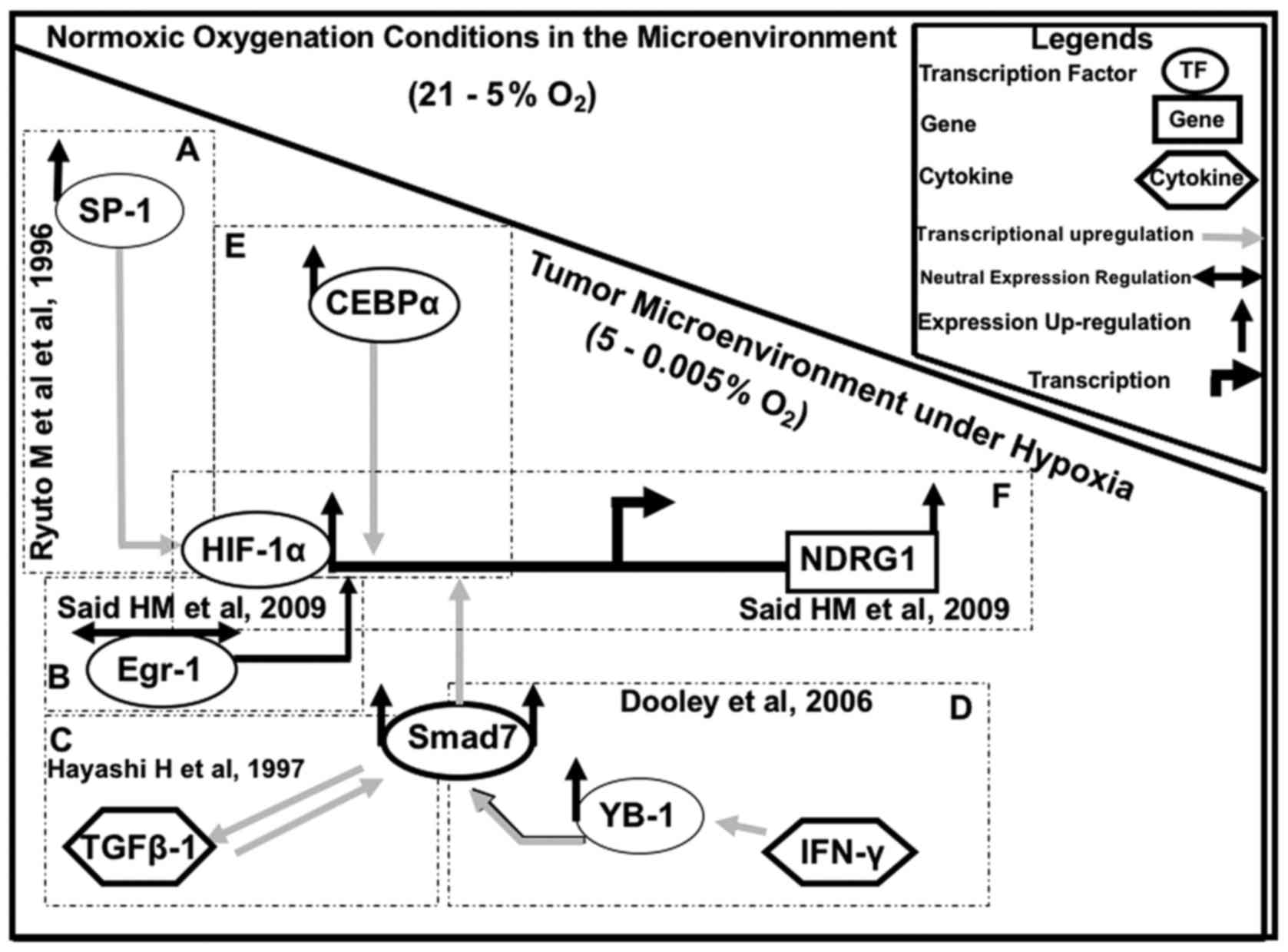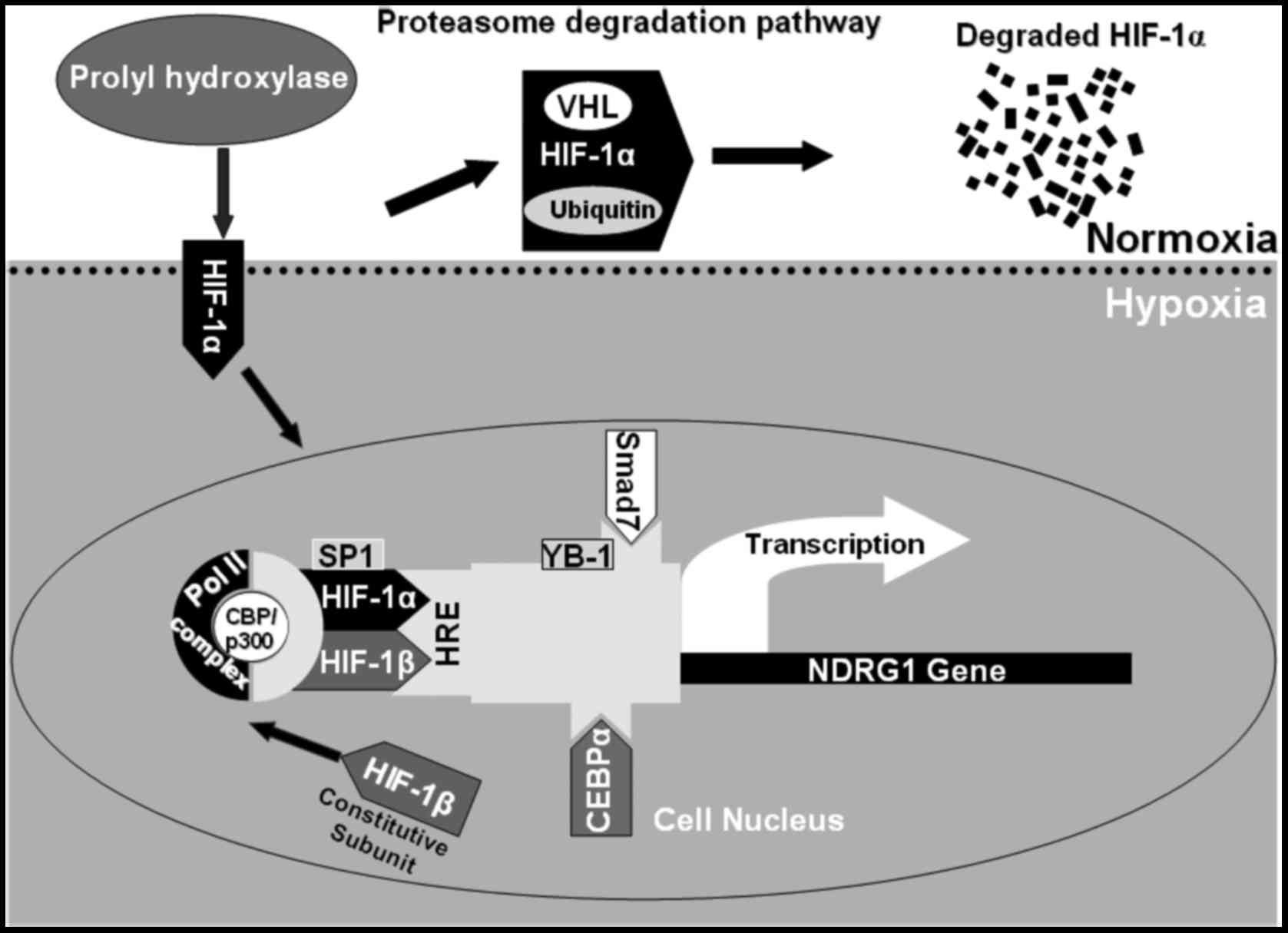|
1
|
Theunissen PH and Blaauw G: Proliferating
cell nuclear antigen immunostaining and survival in cerebral
astrocytoma. Histopathology. 23:75–79. 1993. View Article : Google Scholar : PubMed/NCBI
|
|
2
|
Kaye SB, Bagshawe KD, McElwain TJ and
Peckham MJ: Brain metastases in malignant teratoma: A review of
four years' experience and an assessment of the role of tumour
markers. Br J Cancer. 39:217–223. 1979. View Article : Google Scholar : PubMed/NCBI
|
|
3
|
Molendini L, Benassi MS, Magagnoli G,
Merli M, Sollazzo MR, Ragazzini P, Gamberi G, Ferrari C, Balladelli
A, Bacchini P, et al: Prognostic significance of cyclin expression
in human osteosarcoma. Int J Oncol. 12:1007–1011. 1998.PubMed/NCBI
|
|
4
|
Nam DH, Park K, Park C, Im YH, Kim MH, Lee
S, Hong SC, Shin HJ, Kim JH, Eoh W, et al: Intracranial inhibition
of glioma cell growth by cyclooxygenase-2 inhibitor celecoxib.
Oncol Rep. 11:263–268. 2004.PubMed/NCBI
|
|
5
|
Xie SS, Tan M, Lin HY, Xu L, Shen CX, Yuan
Q, Song XL and Wang CH: Overexpression of adenylate
cyclase-associated protein 1 may predict brain metastasis in
non-small cell lung cancer. Oncol Rep. 33:363–371. 2015.PubMed/NCBI
|
|
6
|
Angst E, Sibold S, Tiffon C, Weimann R,
Gloor B, Candinas D and Stroka D: Cellular differentiation
determines the expression of the hypoxia-inducible protein NDRG1 in
pancreatic cancer. Br J Cancer. 95:307–313. 2006. View Article : Google Scholar : PubMed/NCBI
|
|
7
|
Semenza GL: Involvement of oxygen-sensing
pathways in physiologic and pathologic erythropoiesis. Blood.
114:2015–2019. 2009. View Article : Google Scholar : PubMed/NCBI
|
|
8
|
Said HM, Stein S, Hagemann C, Polat B,
Staab A, Anacker J, Schoemig B, Theobald M, Flentje M and
Vordermark D: Oxygen-dependent regulation of NDRG1 in human
glioblastoma cells in vitro and in vivo. Oncol Rep. 21:237–246.
2009.PubMed/NCBI
|
|
9
|
Ellen TP, Ke Q, Zhang P and Costa M:
NDRG1, a growth and cancer related gene: Regulation of gene
expression and function in normal and disease states.
Carcinogenesis. 29:2–8. 2008. View Article : Google Scholar : PubMed/NCBI
|
|
10
|
Berger P, Young P and Suter U: Molecular
cell biology of Charcot-Marie-Tooth disease. Neurogenetics. 4:1–15.
2002. View Article : Google Scholar : PubMed/NCBI
|
|
11
|
Chua MS, Sun H, Cheung ST, Mason V,
Higgins J, Ross DT, Fan ST and So S: Overexpression of NDRG1 is an
indicator of poor prognosis in hepatocellular carcinoma. Mod
Pathol. 20:76–83. 2007. View Article : Google Scholar : PubMed/NCBI
|
|
12
|
Wangpu X, Yang X, Zhao J, Lu J, Guan S, Lu
J, Kovacevic Z, Liu W, Mi L, Jin R, et al: The metastasis
suppressor, NDRG1, inhibits ‘stemness’ of colorectal cancer via
down-regulation of nuclear β-catenin and CD44. Oncotarget.
6:33893–33911. 2015.PubMed/NCBI
|
|
13
|
Sun B, Chu D, Li W, Chu X, Li Y, Wei D and
Li H: Decreased expression of NDRG1 in glioma is related to tumor
progression and survival of patients. J Neurooncol. 94:213–219.
2009. View Article : Google Scholar : PubMed/NCBI
|
|
14
|
Strzelczyk B, Szulc A, Rzepko R, Kitowska
A, Skokowski J, Szutowicz A and Pawelczyk T: Identification of
high-risk stage II colorectal tumors by combined analysis of the
NDRG1 gene expression and the depth of tumor invasion. Ann Surg
Oncol. 16:1287–1294. 2009. View Article : Google Scholar : PubMed/NCBI
|
|
15
|
Ando T, Ishiguro H, Kimura M, Mitsui A,
Kurehara H, Sugito N, Tomoda K, Mori R, Takashima N, Ogawa R, et
al: Decreased expression of NDRG1 is correlated with tumor
progression and poor prognosis in patients with esophageal squamous
cell carcinoma. Dis Esophagus. 19:454–458. 2006. View Article : Google Scholar : PubMed/NCBI
|
|
16
|
Maruyama Y, Ono M, Kawahara A, Yokoyama T,
Basaki Y, Kage M, Aoyagi S, Kinoshita H and Kuwano M: Tumor growth
suppression in pancreatic cancer by a putative metastasis
suppressor gene Cap43/NDRG1/Drg-1 through modulation of
angiogenesis. Cancer Res. 66:6233–6242. 2006. View Article : Google Scholar : PubMed/NCBI
|
|
17
|
Nakamura K, Yasunaga Y, Segawa T, Ko D,
Moul JW, Srivastava S and Rhim JS: Curcumin down-regulates AR gene
expression and activation in prostate cancer cell lines. Int J
Oncol. 21:825–830. 2002.PubMed/NCBI
|
|
18
|
Bandyopadhyay S, Pai SK, Gross SC, Hirota
S, Hosobe S, Miura K, Saito K, Commes T, Hayashi S, Watabe M, et
al: The Drg-1 gene suppresses tumor metastasis in prostate cancer.
Cancer Res. 63:1731–1736. 2003.PubMed/NCBI
|
|
19
|
Bandyopadhyay S, Pai SK, Hirota S, Hosobe
S, Tsukada T, Miura K, Takano Y, Saito K, Commes T, Piquemal D, et
al: PTEN up-regulates the tumor metastasis suppressor gene Drg-1 in
prostate and breast cancer. Cancer Res. 64:7655–7660. 2004.
View Article : Google Scholar : PubMed/NCBI
|
|
20
|
Cangul H: Hypoxia upregulates the
expression of the NDRG1 gene leading to its overexpression in
various human cancers. BMC Genet. 5:272004. View Article : Google Scholar : PubMed/NCBI
|
|
21
|
Said HM, Polat B, Staab A, Hagemann C,
Stein S, Flentje M, Theobald M, Katzer A and Vordermark D: Rapid
detection of the hypoxia-regulated CA-IX and NDRG1 gene expression
in different glioblastoma cells in vitro. Oncol Rep. 20:413–419.
2008.PubMed/NCBI
|
|
22
|
Arany Z, Huang LE, Eckner R, Bhattacharya
S, Jiang C, Goldberg MA, Bunn HF and Livingston DM: An essential
role for p300/CBP in the cellular response to hypoxia. Proc Natl
Acad Sci USA. 93:pp. 12969–12973. 1996; View Article : Google Scholar : PubMed/NCBI
|
|
23
|
Kallio PJ, Okamoto K, O'Brien S, Carrero
P, Makino Y, Tanaka H and Poellinger L: Signal transduction in
hypoxic cells: Inducible nuclear translocation and recruitment of
the CBP/p300 coactivator by the hypoxia-inducible factor-1alpha.
EMBO J. 17:6573–6586. 1998. View Article : Google Scholar : PubMed/NCBI
|
|
24
|
Le NT and Richardson DR: Iron chelators
with high antiproliferative activity up-regulate the expression of
a growth inhibitory and metastasis suppressor gene: A link between
iron metabolism and proliferation. Blood. 104:2967–2975. 2004.
View Article : Google Scholar : PubMed/NCBI
|
|
25
|
Salnikow K, Costa M, Figg WD and
Blagosklonny MV: Hyperinducibility of hypoxia-responsive genes
without p53/p21-dependent checkpoint in aggressive prostate cancer.
Cancer Res. 60:5630–5634. 2000.PubMed/NCBI
|
|
26
|
Kockar F, Yildrim H, Sagkan RI, Hagemann
C, Soysal Y, Anacker J, Hamza AA, Vordermark D, Flentje M and Said
HM: Hypoxia and cytokines regulate carbonic anhydrase 9 expression
in hepatocellular carcinoma cells in vitro. World J Clin Oncol.
3:82–91. 2012. View Article : Google Scholar : PubMed/NCBI
|
|
27
|
Kusanagi K, Inoue H, Ishidou Y, Mishima
HK, Kawabata M and Miyazono K: Characterization of a bone
morphogenetic protein-responsive Smad-binding element. Mol Biol
Cell. 11:555–565. 2000. View Article : Google Scholar : PubMed/NCBI
|
|
28
|
Yamaguchi T, Matsuzaki K, Inokuchi R,
Kawamura R, Yoshida K, Murata M, Fujisawa J, Fukushima N, Sata M,
Kage M, et al: Phosphorylated Smad2 and Smad3 signaling: Shifting
between tumor suppression and fibro-carcinogenesis in chronic
hepatitis C. Hepatol Res. 43:1327–1342. 2013. View Article : Google Scholar : PubMed/NCBI
|
|
29
|
Neuzillet C, Tijeras-Raballand A, de
Mestier L, Cros J, Faivre S and Raymond E: MEK in cancer and cancer
therapy. Pharmacol Ther. 141:160–171. 2014. View Article : Google Scholar : PubMed/NCBI
|
|
30
|
Dooley S, Hamzavi J, Breitkopf K,
Wiercinska E, Said HM, Lorenzen J, Ten Dijke P and Gressner AM:
Smad7 prevents activation of hepatic stellate cells and liver
fibrosis in rats. Gastroenterology. 125:178–191. 2003. View Article : Google Scholar : PubMed/NCBI
|
|
31
|
Del Vecchio F, Gallo F, Di Marco A,
Mastroiaco V, Caianiello P, Zazzeroni F, Alesse E and Tessitore A:
Bioinformatics approach to predict target genes for dysregulated
microRNAs in hepatocellular carcinoma: Study on a
chemically-induced HCC mouse model. BMC Bioinformatics. 16:4082015.
View Article : Google Scholar : PubMed/NCBI
|
|
32
|
Liu Y, Meyer C, Müller A, Herweck F, Li Q,
Müllenbach R, Mertens PR, Dooley S and Weng HL: IL-13 induces
connective tissue growth factor in rat hepatic stellate cells via
TGF-β-independent Smad signaling. J Immunol. 187:2814–2823. 2011.
View Article : Google Scholar : PubMed/NCBI
|
|
33
|
Szalad A, Katakowski M, Zheng X, Jiang F
and Chopp M: Transcription factor Sp1 induces ADAM17 and
contributes to tumor cell invasiveness under hypoxia. J Exp Clin
Cancer Res. 28:1292009. View Article : Google Scholar : PubMed/NCBI
|
|
34
|
Ryuto M, Ono M, Izumi H, Yoshida S, Weich
HA, Kohno K and Kuwano M: Induction of vascular endothelial growth
factor by tumor necrosis factor alpha in human glioma cells.
Possible roles of SP-1. J Biol Chem. 271:28220–28228. 1996.
View Article : Google Scholar : PubMed/NCBI
|
|
35
|
Minet E, Ernest I, Michel G, Roland I,
Remacle J, Raes M and Michiels C: HIF1A gene transcription is
dependent on a core promoter sequence encompassing activating and
inhibiting sequences located upstream from the transcription
initiation site and cis elements located within the 5′UTR. Biochem
Biophys Res Commun. 261:534–540. 1999. View Article : Google Scholar : PubMed/NCBI
|
|
36
|
Osada S, Takano K, Nishihara T, Suzuki T,
Muramatsu M and Imagawa M: CCAAT/enhancer-binding proteins alpha
and beta interact with the silencer element in the promoter of
glutathione S-transferase P gene during hepatocarcinogenesis. J
Biol Chem. 270:31288–31293. 1995. View Article : Google Scholar : PubMed/NCBI
|
|
37
|
Darlington GJ, Wang N and Hanson RW: C/EBP
alpha: A critical regulator of genes governing integrative
metabolic processes. Curr Opin Genet Dev. 5:565–570. 1995.
View Article : Google Scholar : PubMed/NCBI
|
|
38
|
Hubbi ME and Semenza GL: Regulation of
cell proliferation by hypoxia-inducible factors. Am J Physiol Cell
Physiol. 309:C775–C782. 2015. View Article : Google Scholar : PubMed/NCBI
|
|
39
|
Akslen LA, Andersen KJ and Bjerkvig R:
Characteristics of human and rat glioma cells grown in a defined
medium. Anticancer Res. 8:797–803. 1988.PubMed/NCBI
|
|
40
|
Said HM, Staab A, Hagemann C, Vince GH,
Katzer A, Flentje M and Vordermark D: Distinct patterns of hypoxic
expression of carbonic anhydrase IX (CA IX) in human malignant
glioma cell lines. J Neurooncol. 81:27–38. 2007. View Article : Google Scholar : PubMed/NCBI
|
|
41
|
Said HM, Katzer A, Flentje M and
Vordermark D: Response of the plasma hypoxia marker osteopontin to
in vitro hypoxia in human tumor cells. Radiother Oncol. 76:200–205.
2005. View Article : Google Scholar : PubMed/NCBI
|
|
42
|
Madan A and Curtin PT: A 24-base-pair
sequence 3′ to the human erythropoietin gene contains a
hypoxia-responsive transcriptional enhancer. Proc Natl Acad Sci
USA. 90:pp. 3928–3932. 1993; View Article : Google Scholar : PubMed/NCBI
|
|
43
|
Payen VL, Brisson L, Dewhirst MW and
Sonveaux P: Common responses of tumors and wounds to hypoxia.
Cancer J. 21:75–87. 2015. View Article : Google Scholar : PubMed/NCBI
|
|
44
|
Kitowska A and Pawełczyk T: N-myc
downstream regulated 1 gene and its place in the cellular
machinery. Acta Biochim Pol. 57:15–21. 2010.PubMed/NCBI
|
|
45
|
Wang Q, Li LH, Gao GD, Wang G, Qu L, Li JG
and Wang CM: HIF-1α up-regulates NDRG1 expression through binding
to NDRG1 promoter, leading to proliferation of lung cancer A549
cells. Mol Biol Rep. 40:3723–3729. 2013. View Article : Google Scholar : PubMed/NCBI
|
|
46
|
Salnikow K, Davidson T, Zhang Q, Chen LC,
Su W and Costa M: The involvement of hypoxia-inducible
transcription factor-1-dependent pathway in nickel carcinogenesis.
Cancer Res. 63:3524–3530. 2003.PubMed/NCBI
|
|
47
|
Said HM, Hagemann C, Staab A, Stojic J,
Kühnel S, Vince GH, Flentje M, Roosen K and Vordermark D:
Expression patterns of the hypoxia-related genes osteopontin, CA9,
erythropoietin, VEGF and HIF-1alpha in human glioma in vitro and in
vivo. Radiother Oncol. 83:398–405. 2007. View Article : Google Scholar : PubMed/NCBI
|
|
48
|
Blaes J, Weiler M, Sahm F, Hentschel B,
Osswald M, Czabanka M, Thomé CM, Schliesser MG, Pusch S, Luger S,
et al: NDRG1 prognosticates the natural course of disease in WHO
grade II glioma. J Neurooncol. 117:25–32. 2014. View Article : Google Scholar : PubMed/NCBI
|
|
49
|
Wang Z, Wang F, Wang WQ, Gao Q, Wei WL,
Yang Y and Wang GY: Correlation of N-myc downstream-regulated gene
1 overexpression with progressive growth of colorectal neoplasm.
World J Gastroenterol. 10:550–554. 2004. View Article : Google Scholar : PubMed/NCBI
|
|
50
|
Guan RJ, Ford HL, Fu Y, Li Y, Shaw LM and
Pardee AB: Drg-1 as a differentiation-related, putative metastatic
suppressor gene in human colon cancer. Cancer Res. 60:749–755.
2000.PubMed/NCBI
|
|
51
|
Lai LC, Su YY, Chen KC, Tsai MH, Sher YP,
Lu TP, Lee CY and Chuang EY: Down-regulation of NDRG1 promotes
migration of cancer cells during reoxygenation. PLoS One.
6:e243752011. View Article : Google Scholar : PubMed/NCBI
|
|
52
|
Luo EC, Chang YC, Sher YP, Huang WY,
Chuang LL, Chiu YC, Tsai MH, Chuang EY and Lai LC: MicroRNA-769-3p
down-regulates NDRG1 and enhances apoptosis in MCF-7 cells during
reoxygenation. Sci Rep. 4:59082014. View Article : Google Scholar : PubMed/NCBI
|
|
53
|
Banz VM, Medová M, Keogh A, Furer C,
Zimmer Y, Candinas D and Stroka D: Hsp90 transcriptionally and
post-translationally regulates the expression of NDRG1 and
maintains the stability of its modifying kinase GSK3beta. Biochim
Biophys Acta. 1793:1597–1603. 2009. View Article : Google Scholar : PubMed/NCBI
|
|
54
|
Dominick G, Bowman J, Li X, Miller RA and
Garcia GG: mTOR regulates the expression of DNA damage response
enzymes in long-lived Snell dwarf, GHRKO, and PAPPA-KO mice. Aging
Cell. 16:52–60. 2017. View Article : Google Scholar : PubMed/NCBI
|
|
55
|
Khaliullina H, Love NK and Harris WA:
Nutrient-deprived retinal progenitors proliferate in response to
hypoxia: Interaction of the HIF-1 and mTOR pathway. J Dev Biol.
4:172016. View Article : Google Scholar : PubMed/NCBI
|
|
56
|
Berta MA, Mazure N, Hattab M, Pouysségur J
and Brahimi-Horn MC: SUMOylation of hypoxia-inducible factor-1alpha
reduces its transcriptional activity. Biochem Biophys Res Commun.
360:646–652. 2007. View Article : Google Scholar : PubMed/NCBI
|
|
57
|
Cheng J, Kang X, Zhang S and Yeh ET:
SUMO-specific protease 1 is essential for stabilization of
HIF1alpha during hypoxia. Cell. 131:584–595. 2007. View Article : Google Scholar : PubMed/NCBI
|
|
58
|
Gosslar U, Schmid RM and Holzmann B:
Regulation of Egr-1-dependent gene expression by the C-terminal
activation domain. Biochem Biophys Res Commun. 255:208–215. 1999.
View Article : Google Scholar : PubMed/NCBI
|
|
59
|
Huang RP, Fan Y, Ni Z, Mercola D and
Adamson ED: Reciprocal modulation between Sp1 and Egr-1. J Cell
Biochem. 66:489–499. 1997. View Article : Google Scholar : PubMed/NCBI
|
|
60
|
Koizume S, Ito S, Nakamura Y, Yoshihara M,
Furuya M, Yamada R, Miyagi E, Hirahara F, Takano Y and Miyagi Y:
Lipid starvation and hypoxia synergistically activate ICAM1 and
multiple genes in an Sp1-dependent manner to promote the growth of
ovarian cancer. Mol Cancer. 14:772015. View Article : Google Scholar : PubMed/NCBI
|
|
61
|
Turkoglu SA and Kockar F: SP1 and USF
differentially regulate ADAMTS1 gene expression under normoxic and
hypoxic conditions in hepatoma cells. Gene. 575:48–57. 2016.
View Article : Google Scholar : PubMed/NCBI
|
|
62
|
Zhang P, Tchou-Wong KM and Costa M: Egr-1
mediates hypoxia-inducible transcription of the NDRG1 gene through
an overlapping Egr-1/Sp1 binding site in the promoter. Cancer Res.
67:9125–9133. 2007. View Article : Google Scholar : PubMed/NCBI
|
|
63
|
Salnikow K, Kluz T, Costa M, Piquemal D,
Demidenko ZN, Xie K and Blagosklonny MV: The regulation of hypoxic
genes by calcium involves c-Jun/AP-1, which cooperates with
hypoxia-inducible factor 1 in response to hypoxia. Mol Cell Biol.
22:1734–1741. 2002. View Article : Google Scholar : PubMed/NCBI
|
|
64
|
Lee M, Song SU, Ryu JK and Suh JK:
Sp1-dependent regulation of the tissue inhibitor of
metalloproteinases-1 promoter. J Cell Biochem. 91:1260–1268. 2004.
View Article : Google Scholar : PubMed/NCBI
|
|
65
|
Miki N, Ikuta M and Matsui T:
Hypoxia-induced activation of the retinoic acid receptor-related
orphan receptor alpha4 gene by an interaction between
hypoxia-inducible factor-1 and Sp1. J Biol Chem. 279:15025–15031.
2004. View Article : Google Scholar : PubMed/NCBI
|
|
66
|
Archer MC: Role of sp transcription
factors in the regulation of cancer cell metabolism. Genes Cancer.
2:712–719. 2011. View Article : Google Scholar : PubMed/NCBI
|
|
67
|
Koshikawa N, Hayashi J, Nakagawara A and
Takenaga K: Reactive oxygen species-generating mitochondrial DNA
mutation up-regulates hypoxia-inducible factor-1alpha gene
transcription via phosphatidylinositol 3-kinase-Akt/protein kinase
C/histone deacetylase pathway. J Biol Chem. 284:33185–33194. 2009.
View Article : Google Scholar : PubMed/NCBI
|
|
68
|
Seifeddine R, Fulchignoni-Lataud MC and
Massaad-Massade L: Down-regulation of C/EBPalpha in breast cancer
cells by hypoxia-estrogen combination is mainly due to hypoxia.
Anticancer Res. 29:1227–1231. 2009.PubMed/NCBI
|
|
69
|
Seifeddine R, Dreiem A, Blanc E,
Fulchignoni-Lataud MC, Le Frère Belda MA, Lecuru F, Mayi TH, Mazure
N, Favaudon V, Massaad C, et al: Hypoxia down-regulates
CCAAT/enhancer binding protein-alpha expression in breast cancer
cells. Cancer Res. 68:2158–2165. 2008. View Article : Google Scholar : PubMed/NCBI
|
|
70
|
Gery S, Tanosaki S, Bose S, Bose N,
Vadgama J and Koeffler HP: Down-regulation and growth inhibitory
role of C/EBPalpha in breast cancer. Clin Cancer Res. 11:3184–3190.
2005. View Article : Google Scholar : PubMed/NCBI
|
|
71
|
Chen Z, Zhang D, Yue F, Zheng M, Kovacevic
Z and Richardson DR: The iron chelators Dp44mT and DFO inhibit
TGF-β-induced epithelial-mesenchymal transition via up-regulation
of N-Myc downstream-regulated gene 1 (NDRG1). J Biol Chem.
287:17016–17028. 2012. View Article : Google Scholar : PubMed/NCBI
|
|
72
|
Hayashi M, Martinez OM, Krams SM, Burns W
and Esquivel CO: Cytokines are involved in the rejection of small
intestine allografts. Transplant Proc. 29:18021997. View Article : Google Scholar : PubMed/NCBI
|
|
73
|
Dooley S, Said HM, Gressner AM, Floege J,
En-Nia A and Mertens PR: Y-box protein-1 is the crucial mediator of
antifibrotic interferon-gamma effects. J Biol Chem. 281:1784–1795.
2006. View Article : Google Scholar : PubMed/NCBI
|


















